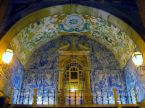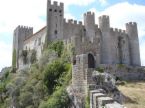For those of us who enjoy a relaxing trip, beautiful landsacpe's, together with a little culture, we take great pleasure in providing the opportunity to do just that.
Portugal may only be a small part of Europe, yet it is home to some of the continent's most ancient history. The Portuguese are very proud of their culture and very much enjoy foreign interest and curiosity.
Located on the Silver Coast, we find ourselves within close proximity of various location's and monument's of great historical importance. Not to mention, the wonderful beaches and restaurant's which surround us, contributing to a varied experience of culture, equestrianism and tranquility.
The following provide's a brief description of what this sensational part of the world has to offer:
SINTRA:
Surrounded by luxurious landscapes, the magical atmosphere of this town was beautifully captured by Lord Byron (acknowledged as one of England's most famous 'romantic' poet's, 1788-1824) as the 'Glorious Eden'. Set within the Natural Park of Sintra-Cascais, the building's flourish with architectural exuberance. From the private house's, to the magnificent 'Pena Palace' sitting on the peak of the slope's overlooking the breath taking valley's, this unique location would most certainly make your visit to Portugal worth while.
Over the centuries, Sintra has been the chosen settlement for many culture's and within more recent times, became widely appreciated by aristocratic society, many of whom writer's and artist's. Much of it's character is found in the remaining presence of wonderful remnant's left by the Arab's, including ancient tile's, courtyard's and fountain's abundantly distributed throughout the town.
D. Alfonso Henriques, the first King of Portugal, conquered the Moor's and attained the castle in the XII century, which remained a Royal residence for many of his successors throughout history.
When visiting Sintra, one of the great pleasure's is to simply enjoy a relaxing coffee, accompanied by a freshly baked tradition, 'Queijada of Sintra' - a unique cake, known to have existed all those centuries ago, when the Portuguese claimed what was truly their's.
 Breath taking landscape's |  Pena Palace garden's |
 Quinta de Regaleira garden's |  Pena Palace |
MAFRA:
Set in the 'Saloia' region, the Palace/Convent of Mafra is a fabulous and unique example of XVIII century architecture, allowing visitor's a glance into what was once the grand splendour of Portuguese Royalty.
D. João V married D. Maria Ana of Austria and it is believed that the inspiration for such a wonderful monument came from the King's promise to the Princess to build a Convent once their first child was born. Therefore, in 1717 after the arrival of their daughter, Princess Barbara of Bragança, construction began and was completed in time for inauguration on the King's 41st birthday in 1730. Part of this promise was that the Convent would be dedicated to the Fransiscan Monks, of whom many artefacts remain to be seen today.
Behind this grand Palace, a Royal Reserve stretches as far as the eye can see (approximately 25 square kilometres). Once used for the King's enjoyment of the chase, it is now divided into two individual part's. One is used as a training ground for both the Infantry and Cavalry, whose Barrack's stand on either side of the Palace. On the farther side, the Reserve become's a national wildlife sanctuary where visitor's are encouraged to observe it's beauty on horseback. With just a little luck, sighting's of the wild boar and deer may be experienced along the way.
 Palace of Mafra |  Palace Library |
 Deer from the Royal Reserve |  Lake in the Royal Reserve |
ÓBIDOS:
This magnificent medieval fortified village makes for a wonderful afternoon's outing.
Óbidos became of true existence when the Moor's, in the VIII century, overthrew the Roman's from their nearby settlement. However, once more D. Alfonso Henriques defeated the Moor's during his reign and occupied the castle, along with it's fort in 1148. It remained a Royal abode until fairly recently in the XVIII century. (The Latin origin of the word 'óbidos' means 'fortified city'.)
Many great example's of architectural decor are there for admiration due to various phase's of remodelling throughout the centuries, such as the artistic tile's found within the southern archway.
On a visit to Óbidos, a taste of the renownd 'Ginja de Óbidos' (Cherry Brandy), while sat enjoying the passer's by and peaceful atmosphere found within the walls, is a perfect way to reflect on the surrounding beauty.
 Southern Entrance |  The Castle |
 Cobbled Street's |  The Great Wall |